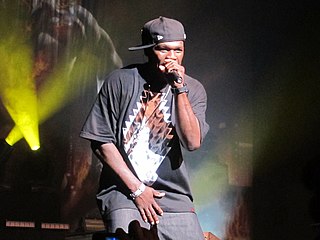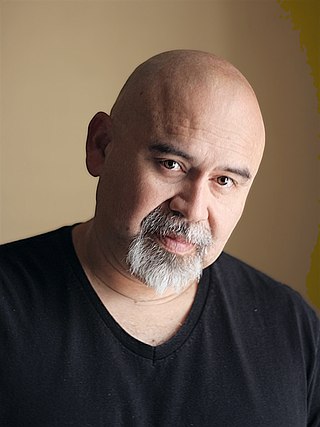Latin hip hop is hip hop music that is recorded by artists in the United States of Hispanic and Latino descent, along with Spanish-speaking countries in the Caribbean, North America, Central America, South America, and Spain.

Rapping is an artistic form of vocal delivery and emotive expression that incorporates "rhyme, rhythmic speech, and [commonly] street vernacular". It is usually performed over a backing beat or musical accompaniment. The components of rap include "content", "flow", and "delivery". Rap differs from spoken-word poetry in that it is usually performed off-time to musical accompaniment. It also differs from singing, which varies in pitch and does not always include words. Because they do not rely on pitch inflection, some rap artists may play with timbre or other vocal qualities. Rap is a primary ingredient of hip hop music, and so commonly associated with that genre that it is sometimes called "rap music".
The new school of hip hop was a movement in hip hop music, beginning in 1983–84 with the early records of Run–D.M.C., Whodini, and LL Cool J. Predominantly from Queens and Brooklyn, it was characterized by drum machine-led minimalism, often tinged with elements of rock; rapped taunts, boasts, and socio-political commentary; and aggressive, self-assertive delivery. In song and image, its artists projected a tough, cool, street b-boy attitude. These elements contrasted sharply with funk and disco, novelty hits, live bands, synthesizers, and party rhymes of artists prevalent in the early 1980s. Compared to their older hip hop counterparts, new school artists crafted more cohesive LPs and shorter songs more amenable to airplay. By 1986, their releases began to establish hip hop in the mainstream.
East Coast hip hop is a regional subgenre of hip hop music that originated in New York City during the 1970s. Hip hop is recognized to have originated and evolved first in The Bronx, New York City.
West Coast hip hop is a regional genre of hip hop music that encompasses any artists or music that originated in the West Coast of the United States. West Coast hip hop began to dominate from a radio play and sales standpoint during the early to-mid 1990s with the birth of G-funk and the emergence of record labels such as Suge Knight and Dr. Dre's Death Row Records, Ice Cube's Lench Mob Records, the continued success of Eazy-E's Ruthless Records, Dr. Dre's Aftermath Entertainment, and others.

The music of El Salvador refers to the Music of the Republic of El Salvador and is encompassed in the wider Latin American musical traditions.
Horrorcore, also called horror hip hop, horror rap, death hip hop, death rap, or murder rap is a subgenre of hip hop music based on horror-themed and often darkly transgressive lyrical content and imagery. Its origins derived from certain hardcore hip hop and gangsta rap artists, such as the Geto Boys and Three 6 Mafia, which began to incorporate supernatural, occult, and psychological horror themes into their lyrics. Unlike most hardcore hip hop and gangsta rap artists, horrorcore artists often push the violent content and imagery in their lyrics beyond the realm of realistic urban violence, to the point where the violent lyrics become gruesome, ghoulish, unsettling, inspired by slasher films or splatter films. While exaggerated violence and the supernatural are common in horrorcore, the genre also frequently presents more realistic yet still disturbing portrayals of mental illness and drug abuse. Some horrorcore artists eschew supernatural themes or exaggerated violence in favor of more subtle and dark psychological horror imagery and lyrics.
Hip hop music arrived in Cuba via radio and TV broadcasts from Miami. During the 1980s hip hop culture in Cuba was mainly centered on breakdancing. But by the 1990s, with the collapse of the Soviet Union and the onset of the Special Period, young raperos, exposed to foreign tourists whose wealth highlighted their struggle, turned to rapping to affirm their cubanidad and advocate for further revolutionary reforms.

Rap rock is a music genre that developed from the early to mid-1980s, when hip hop DJs incorporated rock records into their routines and rappers began incorporating original and sampled rock instrumentation into hip hop music. Rap rock is considered to be rock music in which lyrics are rapped, rather than sung. The genre achieved its greatest success in the late 1990s and early 2000s.

IAM is a French hip hop band from Marseille. Formed in 1989, it comprises Akhenaton, Shurik'n, Khéops, Imhotep and Kephren. IAM has several meanings, including Invasion Arrivée de Mars. Another meaning is Imperial Asian Man, while AKH often refers to L'homme Impérial Asiatique.

Yo! MTV Raps was an American two-hour television music video program, which first aired on MTV Europe from 1987 to mid-90s and on MTV US from August 1988 to August 1995. The American version of the program was the first hip hop music show on the network, and was based on the original MTV Europe show, which first aired one year before the American version. Yo! MTV Raps produced a mix of rap videos, interviews with rap stars, live in-studio performances, and comedy. The show also yielded a Brazilian version called Yo! MTV and broadcast by MTV Brasil from 1990 to 2005.

Golden age hip hop refers to mainstream hip hop music created from the mid or mid-late 1980s to the early or early-mid 1990s, particularly by artists and musicians originating from the New York metropolitan area. A precursor to the new-school hip hop movement, it is characterized by its diversity, quality, innovation and influence on overall hip hop after the genre's emergence and establishment in the old-school era, and is associated with the development and eventual mainstream success of hip hop. There were various types of subject matter, while the music was experimental and the sampling from old records was eclectic.
Pescozada is a hip hop group formed in Chalatenango, El Salvador. Their name means "slap" or "punch" in modern Spanish. They are also well known throughout El Salvador for addressing political situation, its problems, and its civil war.

Bottle of Humans is the debut solo studio album by American hip hop artist Sole. It was released on Anticon in 2000. It peaked at number 14 on CMJ's Top 25 Hip-Hop chart.

Omnionn is a music producer of Salvadoran music. He is particularly active in the Salvadoran hip hop scene, where he is the official producer of Pescozada. He is also widely known as an artist of Electronic music. Ominonn resided in San Francisco, California for most of his life, but has dedicated himself to help establish an urban music scene in El Salvador, and in 2006 moved back to his home country.
Hip-hop or hip hop, also known as rap, and formerly known as disco rap, is a genre of popular music that originated in the early 1970s by African Americans and Caribbean immigrants in the Bronx, a borough of New York City. Hip-hop music originated as an anti-drug and anti-violence genre consisting of stylized rhythmic music that often accompanies rapping, a rhythmic delivery of poetic speech. According to the professor Asante of African American studies at Temple University, "hip hop is something that blacks can unequivocally claim as their own". The music developed as part of the broader hip hop culture, a subculture defined by four key stylistic elements: MCing/rapping, DJing/scratching with turntables, breakdancing, and graffiti art. While often used to refer solely to rapping and rap music, "hip hop" more properly denotes the practice of the entire subculture. The term hip hop music is sometimes used synonymously with the term rap music, though rapping is not a required component of hip hop music; the genre may also incorporate other elements of the culture, including DJing, turntablism, scratching, beatboxing, and instrumental tracks.
Alternative hip hop is a subgenre of hip hop music that encompasses a wide range of styles that are not typically identified as mainstream. AllMusic defines it as comprising "hip hop groups that refuse to conform to any of the traditional stereotypes of rap, such as gangsta, bass, hardcore, and party rap. Instead, they blur genres drawing equally from funk and pop/rock, as well as jazz, soul, reggae, and even folk."

Elliott Wilson is an American journalist, television producer, and magazine editor. He is the founder and CEO of Rap Radar. In the past, he has worked as editor-in-chief of XXL Magazine. While there, he became known for his editorials under the nickname "YN".

HipHopDX is an online magazine of hip hop music criticism and news. The website's current president and publisher is Sharath Cherian and the Head of Content is Jerry L. Barrow. HipHopDX is the flagship publication of Cheri Media Group.
Sri Lankan Hip Hop is a part of the Asian hip hop culture. This multilingual genre features Sinhala, Tamil and English.










